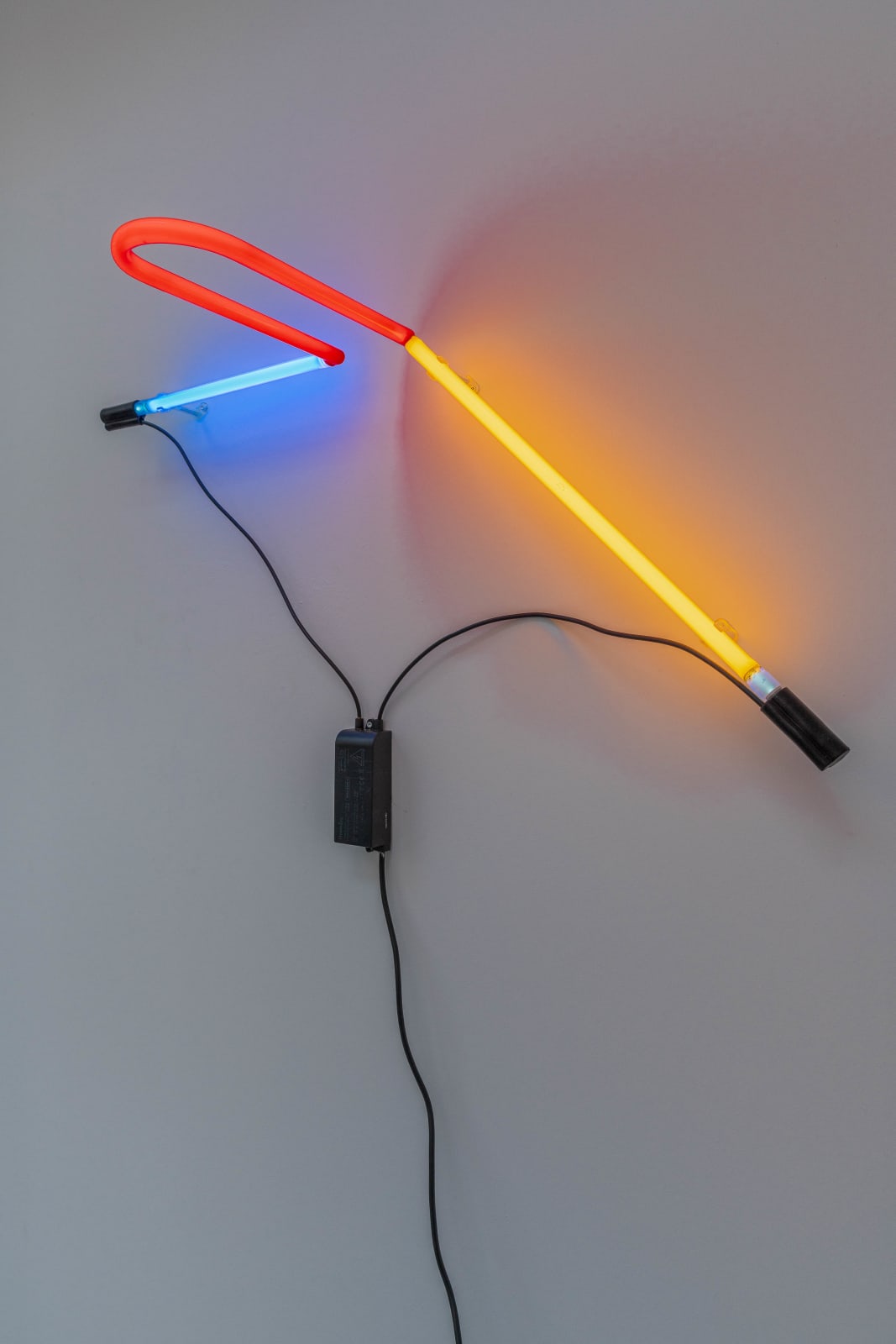Keith Sonnier
Drone A, 2014/2020
Neon, cable and transformer
81 x 51 x 28 cm
31 7/8 x 20 1/8 x 11 1/8 inches
31 7/8 x 20 1/8 x 11 1/8 inches
Ed. 1/5
Copyright The Artist
Photo: Dirk Tacke
Further images
Die Wandskulptur Drone A (2014/2020) ist aus einer Neonröhre zusammengesetzt, die in den Grundfarben Blau, Rot und Gelb strahlt. Keith Sonnier verwendet Neon durchgängig in seinem Werk als Konnektiv, das...
Die Wandskulptur Drone A (2014/2020) ist aus einer Neonröhre zusammengesetzt, die in den Grundfarben Blau, Rot und Gelb strahlt. Keith Sonnier verwendet Neon durchgängig in seinem Werk als Konnektiv, das die Verbindung zwischen technologischen Entwicklungen und ästhetischem Ausdruck zusammenführt. Zudem erkundet der Künstler in seinen Arbeiten die physikalischen Eigenschaften von Neonlicht, welches sich räumlich ausdehnt und materielle Grenzen überschreiten kann. Sonnier sah die Arbeit mit Licht in Zusammenhang zu neuen Technologien seiner Zeit. Für ihn schwebte Neongas, das ein diffuses, amorphes Leuchten abgibt, in der Atmosphäre, so ungreifbar und unfixiert wie Radiowellen und Satellitendaten. Wie diese Technologien, erschien Neon grenzenlos zu sein, die radierenden Wellen des Lichts visualisieren eine Welt, in der Distanzen geringer werden und die Steuerung eines Flugobjekts ohne Besatzung, durch ferngesteuerte Navigation möglich ist.
Sonnier war in den 60er und 70er Jahren einer der ersten Künstler, der Neon und Kommunikationsstrukturen zusammenbrachte und half die räumliche und kulturelle Logik dieser Systeme, mit Hilfe der einzigartigen Wahrnehmungseigenschaften von Neonlicht im realen Raum zu materialisieren. Neben der Auflösung der materiellen Schwere der Skulptur durch Licht revolutioniere Sonnier den Skulpturenbegriff durch seinen Einsatz von Industriematerialien wie Neon, Latex, Schaumstoff oder Aluminium.
The wall sculpture “Drone A” (2014/2020) is composed of a shining neon tube in the base colors blue, red and yellow. Keith Sonnier uses neon throughout his work as a link, merging technological developments and aesthetic expression. Additionally, the artist explores the physical properties of neon light, which expands spatially and is able to cross material boundaries. Sonnier saw his work with light intertwined with the new technologies of his time. For him, neon gas, with its diffuse, amorphous glow, floats in the atmosphere, as intangible and unfixed as radio waves and satellite data. Like these technologies, neon is limitless, the ephemeral waves of light a way to visualize a world in which distances are ever decreasing and an unmanned flying object can be controlled by remote-controlled navigation.
Sonnier was one of the first artists in the 60s and 70s to interconnect neon light and communication structures. He assisted in materializing the spatial and cultural logic of these systems into real space with the help of the unique perceptual properties of neon light. In addition to the dissolution of the material weight of the sculpture through light, Sonnier revolutionized the concept of sculpture through his use of industrial materials such as neon, latex, foam and aluminum.
Sonnier war in den 60er und 70er Jahren einer der ersten Künstler, der Neon und Kommunikationsstrukturen zusammenbrachte und half die räumliche und kulturelle Logik dieser Systeme, mit Hilfe der einzigartigen Wahrnehmungseigenschaften von Neonlicht im realen Raum zu materialisieren. Neben der Auflösung der materiellen Schwere der Skulptur durch Licht revolutioniere Sonnier den Skulpturenbegriff durch seinen Einsatz von Industriematerialien wie Neon, Latex, Schaumstoff oder Aluminium.
The wall sculpture “Drone A” (2014/2020) is composed of a shining neon tube in the base colors blue, red and yellow. Keith Sonnier uses neon throughout his work as a link, merging technological developments and aesthetic expression. Additionally, the artist explores the physical properties of neon light, which expands spatially and is able to cross material boundaries. Sonnier saw his work with light intertwined with the new technologies of his time. For him, neon gas, with its diffuse, amorphous glow, floats in the atmosphere, as intangible and unfixed as radio waves and satellite data. Like these technologies, neon is limitless, the ephemeral waves of light a way to visualize a world in which distances are ever decreasing and an unmanned flying object can be controlled by remote-controlled navigation.
Sonnier was one of the first artists in the 60s and 70s to interconnect neon light and communication structures. He assisted in materializing the spatial and cultural logic of these systems into real space with the help of the unique perceptual properties of neon light. In addition to the dissolution of the material weight of the sculpture through light, Sonnier revolutionized the concept of sculpture through his use of industrial materials such as neon, latex, foam and aluminum.
1
of
9







